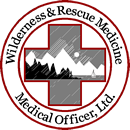Hypodermoclysis
©Jeffrey E Isaac, PA-C
This venerable technique has generated some interest for marine medical training. The Standards for Training and Watch Keeping (STCW) now being imposed on professional mariners requires competence in intravenous therapy for Level III medical providers, known as the “Person in Charge of Medical Care Aboard Ship” (PIC). This mean that lots of deck officers are going to be cannulating plastic veins in latex arms to learn how to start IV’s. A few lucky ones will have the opportunity to practice this skill on the real thing. Few of them will really become skilled enough to perform reliably on a sick and dehydrated patient. It takes lots of practice.
Hypodermoclysis might be a more appropriate technique for the casual user. Fluid is simply infused into the spaces under the skin from where it is absorbed into the circulatory system. Cannulating a vein is not required. The needle is simply inserted under the skin on the back, chest, abdomen, or thighs. There is much less risk of blood clots, infection, and phlebitis. It can be left in place for days, if necessary. The same fluid bags and tubing are used as with IV therapy. Hypodermoclysis may be a good back-up technique for cases where IV therapy is not possible.
Infusion rates are much slower than with IV therapy, but up to 3 liters of fluid can be given over 24 hours. This is adequate for most cases of sea sickness or dehydration from other illness. It can also be bolused (inject a larger quantity all at once) at 60 – 100 cc at a time if a line cannot be maintained.
Ashore, the technique is often taught to unskilled care givers responsible for elderly or ill patients that are managed at home. The other major users of hypodermoclysis are veterinarians. Their patients do not often tolerate IV therapy. The vets bolus the cat or dog with Normal Saline or other fluid in several sites. The critter is then free to go while the fluid is absorbed over time.
It is not surprising that techniques and equipment used in home health care and veterinary medicine are often more appropriate for the marine world than those used in the emergency room. Hospitals are notoriously flat, well-lit, dry, warm, immobile, and filled with medical professionals. What offshore cruising boat looks like that?

